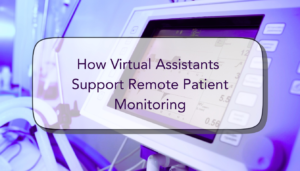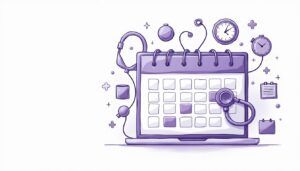What Does a Remote Medical Scribe Do? A Comprehensive Guide
07 Oct 2025 By: Mary Dellosa
Updated

Today’s busy healthcare world demands strong documentation for good care, correct billing, and clear team communication. But many providers feel swamped by charting work. Remote medical scribes ease this load by handling notes, which helps doctors stay focused on patients.
This guide explains what does a remote medical scribe do, their pros, cons, and where the job is headed. It’s for healthcare workers wanting help or anyone eyeing this career path. You’ll see real examples, helpful facts, and the latest insights woven throughout the guide.
Understanding the Role of a Remote Medical Scribe
What Is a Medical Scribe?
A medical scribe is there to catch every word during a doctor’s visit. They write it all down so the doctor can focus on the patient, not the computer.
Many scribes now work from home. They join visits online and type notes while the doctor talks. This helps doctors give more attention to their patients.
Key Responsibilities of Remote Medical Scribes
Remote medical scribes handle a wide range of tasks aimed at supporting healthcare providers. Their core responsibilities include:
- Real-time Notes: Scribes write down what’s said during visits, like patient history, exams, and care plans.
- Record Updates: They keep patient charts organized and up to date in the system.
- Billing Help: Scribes add codes for tests and treatments to help with accurate billing.
- Team Support: They work with the care team to clear up notes or follow up on missing details
Remote scribes are quiet helpers who make a big difference. They need to know medical terms, use health record systems, and protect patient privacy. They also need to listen well and share info clearly so nothing gets lost between the doctor and patient. A small mistake in notes can affect care, so being focused and careful is a must.
The role is growing and changing. Many scribes now team up with smart tools like AI to take notes faster and more accurately. This lets doctors stay focused on the patient not a computer screen. As healthcare keeps changing, scribes remain a steady hand behind the scenes. They help everything flow so doctors can give care that feels personal and human.
The Growing Demand for Remote Medical Scribes
Why Remote Scribing Has Become Popular
The healthcare industry has seen a significant shift toward remote work models, accelerated by the COVID-19 pandemic. Telemedicine visits surged by over 38 times from pre-pandemic levels in 2020, according to the CDC, creating a natural demand for remote support services like medical scribes.
Remote scribing comes with key benefits:
Flexibility: Doctors can work anywhere without needing in-person scribes.
Cost Savings: Clinics save money on office space and on-site staff.
Wider Talent Pool: They can hire top scribes from any location.
Thanks to new tech, remote scribes can now help from anywhere. They use secure tools to take notes while the doctor talks with the patient. This means doctors can look up, listen closely, and connect with their patients. It makes the visit feel more natural, relaxed, and human for everyone.
Industry Statistics and Trends
A 2023 report from the AMA shows that almost 60% of doctors now use scribes to ease paperwork. Remote scribes, in particular, have grown fast—about 25% each year over the last five years.
A survey by the Medical Scribe Association found that 85% of doctors using remote scribes felt less stressed and more present with their patients. It’s a clear sign that remote scribes are becoming an essential part of how care is given today.
They help doctors stay accurate with notes, avoid mistakes, and meet important rules. By having trained people handle documentation, care becomes safer and more reliable.
This shift isn’t just a quick fix from the pandemic, it’s a lasting change. As patients want faster, easier care, remote scribes help doctors keep up and give more focused, personal care.
How Remote Medical Scribes Work: Tools, Processes, and Workflow
Technology Behind Remote Scribing
Remote medical scribes rely heavily on technology to perform their duties efficiently and securely. Key tools include:
- Electronic Health Records (EHR): Systems like Epic, Cerner, and Allscripts store patient info and help doctors see full medical histories in one place.
- Secure Video Calls: HIPAA-safe video tools let scribes watch visits live. This helps them catch key details and keeps notes more personal and accurate.
- Voice-to-Text Tools: Some scribes use speech software to speed up note-taking. But many still type notes by hand to keep things clear and correct.
- Secure Messaging: Encrypted channels protect patient info during remote work. This keeps data safe and builds trust between patients and providers.
Typical Workflow of a Remote Medical Scribe
The daily flow of a remote scribe usually follows a few simple steps
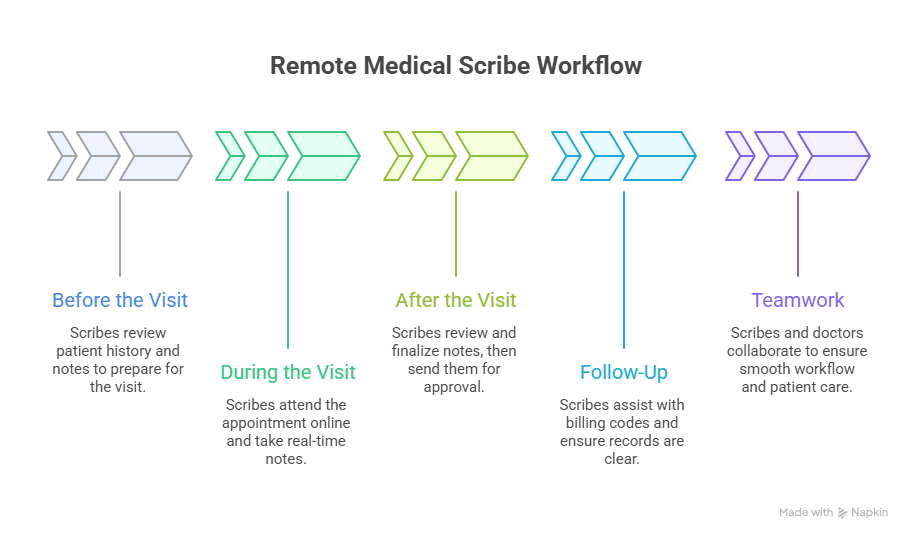
Before the Visit: Scribes look over the patient’s history, past notes, and treatments. This helps them get ready and know what to expect during the visit.
During the Visit: Scribes join the appointment online and take notes in real time. They stay focused, capturing key details, care plans, and patient concerns.
After the Visit: They review and clean up the notes, double-check everything, and send them to the doctor for approval. Accuracy really matters here.
Follow-Up: Scribes may help with billing codes or fix any missing info. They often work with other staff to keep records clear and payments on track.
Good teamwork between the scribe and doctor is key. When they trust and understand each other, the work flows better and mistakes are less likely.
This strong connection helps them stay focused on what matters most—caring for the patient. Scribes also keep learning through training, so they stay sharp and bring even more value to the care team.
Benefits of Using Remote Medical Scribes
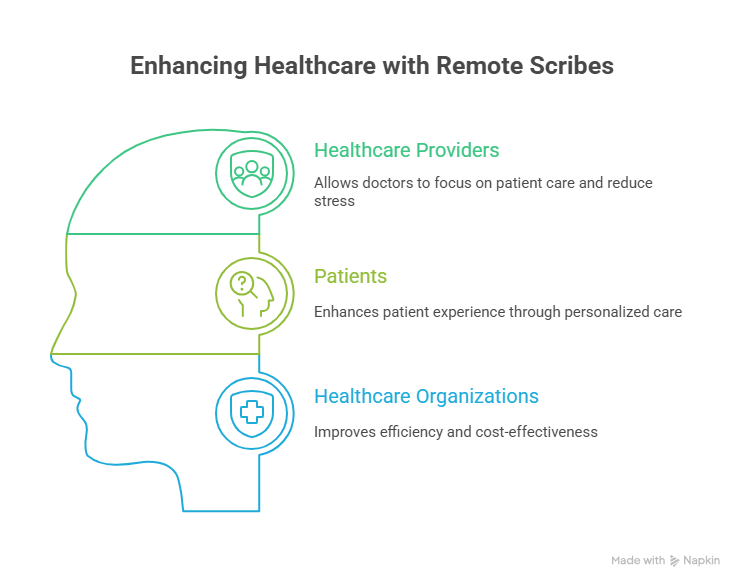
For Healthcare Providers
Remote scribes handle the notes so doctors can give patients their full attention. Instead of typing, doctors can listen, connect, and focus on care. This extra help lowers stress and brings back the personal touch in each visit.
Scribes also make sure nothing important gets missed. Their careful notes help doctors make better choices and keep billing on track. Clear records mean patients get the right care at the right time.
For Patients
Patients may not see the scribe, but they feel the care. With the doctor fully focused, visits feel more calm and personal. Patients feel heard and understood.
When there’s trust, people open up more and follow their care plan. That connection helps doctors give better care—and helps patients heal and feel supported.
For Healthcare Organizations
Healthcare teams that bring in remote scribes often feel the difference right away. With less time spent fixing chart errors or chasing paperwork, things run smoother. Patients move through visits faster, billing is cleaner, and the whole system saves time and money. When care needs shift—like during a telehealth surge—remote scribes help teams adjust quickly without missing a beat.
They also bring doctors and staff closer together. Without the weight of constant note-taking, doctors have more time to talk with their team, share ideas, and focus on care. This creates a more connected, flexible environment one where everyone works together to give patients the best care possible.
Challenges and Considerations in Remote Medical Scribing
Maintaining Data Security and Privacy
Working with patient info remotely comes with risks. Data must be kept safe from hacks or leaks. That’s why strong security is a must. Encrypted tools, secure logins, and regular checks help protect records. Only the right people should have access, and staff need training to spot threats. Implementing robust cloud security measures ensures that sensitive patient information stored or shared online remains fully protected against unauthorized access.
Teaching teams to avoid phishing and use strong passwords is key. Secure cloud systems also help by keeping info up to date and private at the same time.
Communication Barriers
Remote scribes can miss small details if the audio or video isn’t clear. This can lead to mistakes or gaps in the notes. To avoid this, doctors and scribes need to set clear ways to stay in touch and check in often. Quick follow-ups help clear up any confusion.
Using strong internet and good video tools also makes a big difference. Clear sound and picture help scribes catch every word and detail the first time.
Training and Skill Requirements
Remote medical scribes need the right training to do their job well. They learn medical terms, how to use health record systems, and how to stay focused at home. They also need people skills—like clear communication and good time habits to keep things running smoothly.
Since healthcare keeps changing, scribes keep learning too. Having a mentor helps a lot. An experienced scribe can offer support, answer questions, and help new scribes feel more confident.
Potential Impact on Provider-Patient Relationship
Scribes help doctors focus on you, not a screen. But it’s okay to feel unsure if someone else is quietly listening. That’s why your doctor should explain who the scribe is and ask if you’re comfortable. A simple chat can help ease your mind. You should always feel safe and heard. When your doctor listens and makes time for your questions, it helps you feel more at ease.
Once you know the scribe is just there to help, the visit can feel more relaxed and more focused on you.
How to Become a Remote Medical Scribe
Educational Background and Skills Needed
Most remote medical scribes have studied health, biology, or similar fields. They need to type fast, notice small details, and use EHR software well. Knowing medical terms and how clinics work helps them keep records clear and correct.
Training Programs and Certifications
If you want to be a medical scribe, there’s help to get started. Groups like ACMSS and AHDPG teach you the basics how the body works, what medical terms mean, how to take notes, and how to keep info safe.
These programs help you learn what you need to do the job well and support doctors and patients with care.
Job Outlook and Career Path
As telehealth grows, the need for remote scribes is rising too. New scribes can move up over time into roles like documentation specialist, health info manager, or medical coder. It’s a strong starting point for a career in healthcare.
The Future of Remote Medical Scribing
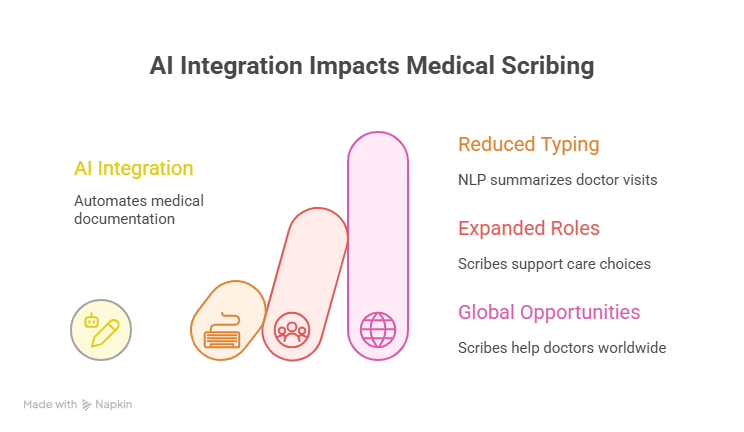
Integration with Artificial Intelligence
AI tools are starting to change how medical scribing works. Tech like natural language processing can listen, type, and even sum up doctor visits, cutting down on typing. But human scribes are still key. They catch details, understand context, and handle tricky cases that AI might miss.
In the future, scribes and AI may work together mixing speed with human care and judgment.
Expanding Roles and Responsibilities
As healthcare changes, scribes may do more than just write notes. They might help check charts, find helpful info, and support doctors in making care choices.
Scribes could become a bigger part of the care team, working with doctors and nurses to help patients feel cared for and supported.
Global Opportunities
Remote scribing isn’t limited to one country. With secure tech, scribes can help doctors anywhere in the world. This opens doors for people from many places to work together and share skills.
Trending Now
This qualitative study explored how medical scribes influence healthcare provider burnout caused largely by electronic health record (EHR) demands. Data were collected between 2017 and 2019 through site visits, interviews with former scribes (now medical students), and expert conferences, producing 184 transcripts analyzed for themes. Results showed that scribes reduce provider frustration and exhaustion by easing documentation burdens, improving job satisfaction, extending careers, and sometimes preventing early retirement.
However, scribes themselves often experience burnout due to workload, low pay, and emotional strain, occasionally discouraging them from pursuing medical careers. The study concludes that while scribes help mitigate provider burnout, they are not a permanent solution, as systemic EHR issues and workflow inefficiencies remain the root causes. Improving EHR usability and team integration is essential to address burnout for both providers and scribes.
Conclusion
Remote medical scribes are quiet helpers who make a big difference. They handle the notes so doctors can focus fully on their patients. This helps visits feel more personal and less rushed. Since scribes can work from anywhere, they fit right into today’s world of telehealth and digital care.
There are some challenges, but better tools and training are making the job even stronger. For doctors, clinics, or anyone wanting to be a scribe, it’s important to understand the role. It’s more than typing, it’s about helping people get better care every day. Looking to add a remote scribe to your team? HelpSquad Health offers trained, reliable scribes ready to support your practice. Contact us today to get started.

